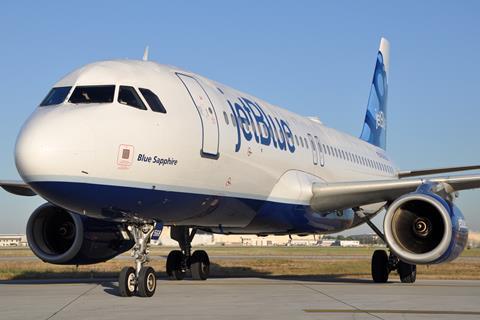JetBlue Airways boosted revenue in the second quarter of 2022 and has begun making preparations to swallow its newest prize, ultra-low-cost carrier (ULCC) Spirit Airlines.
The New York-based carrier said on 2 August that sales during the second quarter of 2022 topped $2.45 billion, about 63% higher than during the second quarter of 2021, when the airline reported revenue of $1.5 billion. It’s also 16% higher than the $2.1 billion the company posted in pre-pandemic 2019.
But with expenses from increased operations rising as well, the company said it lost $188 million during the quarter. Last year, the company reported a profit of $64 million, which included federal payroll support. Excluding special items, which included the government grants, JetBlue would have lost $206 million in the second quarter of 2021.

In 2019, the company posted a $179 million profit during the three months between April and June.
In the past year, expenses increased by 89% to $2.56 billion from $1.35 billion in the same period last year.
“We reported a record-breaking revenue result for the second quarter, and we’re on pace to top it again here in the third quarter and drive our first quarterly profit since the start of the pandemic,” says chief executive Robin Hayes. “We’ve entered the third quarter with some solid momentum that we expect to carry through to a sustained profit inflection.”
Executives add the airline will return to profitability in the second half of 2022.
JETBLUE-SPIRIT DEAL
Last week, JetBlue announced it would be acquiring Spirit Airlines, snatching the Florida-headquartered ultra-low-cost carrier away from ULCC peer Frontier Airlines after a protracted months-long battle.
“I’m very pleased we found a path forward with Spirit … as we create a true, national low-fare challenger to the dominant ‘Big Four’ airlines,” Hayes adds. “This transaction turbo-charges our strategic growth plan.” The ultimate goal is to “combine the best of both companies”.
Hayes adds that he is ”confident” the deal will obtain regulatory approval no later than during the first half of 2024.
“On the regulatory front [we have] a sense that we expected this to take a fair amount of time…obviously we are not in control of the timeline but we are active participants in the process,” Hayes continues.
“We will continue to engage with the Department of Justice and the Department of Transportation through the process. It’s a process that is going to take some time and we want to be respectful of the regulators’ view and right to review this transaction.”
For the moment, the company is focusing on getting Spirit’s shareholders to agree to the deal, which is worth $3.8 billion. Hayes adds that he expects a special shareholder meeting to take place within the next 60-90 days.
The five-month tug-of-war for Spirit concluded last week when it called off its planned merger with Frontier in favour of a combination with JetBlue. After Frontier made an acquisition offer for Spirit in February, JetBlue responded with a hostile takeover bid in April.
Since then, the Spirit board of directors had repeatedly encouraged the airline’s shareholders to vote for the Frontier deal, before abruptly changing direction when it was clear the support for the tie-up with the Denver-based carrier would not materialise.
On 28 July, Spirit said it would agree to the JetBlue offer, and encouraged shareholders to do the same.
COST CONTROL
As for the rest of the year, JetBlue says it’s launching cost-savings measures in order to return to profitability.
During the third quarter, capacity is projected to be between flat to 3% lower than during pre-pandemic 2019. For the full year, the company is aiming for 0-3% capacity growth across the system.
“We’re embarking on a new plan to keep our costs low, focused on cross-functional costs and applying best practices with respect to operational and planning efficiencies. Through the strong underlying momentum in the business and the continued execution of our various strategic initiatives,” chief financial officer Ursula Hurley says. “We are setting a foundation to structurally improve our long-term earnings potential.”
The airline is ramping up its fleet modernisation by accelerating retirements of its ageing Embraer E190 aircraft and replacing them with more-efficient Airbus A220s. These fleet changes alone are expected to drive approximately $75 million in cost savings through 2024, Hurley adds. Additional cost savings will come from structural changes such as ”network efficiency, crew planning, end-of-life maintenance optimisation and maximising asset productivity”.












































